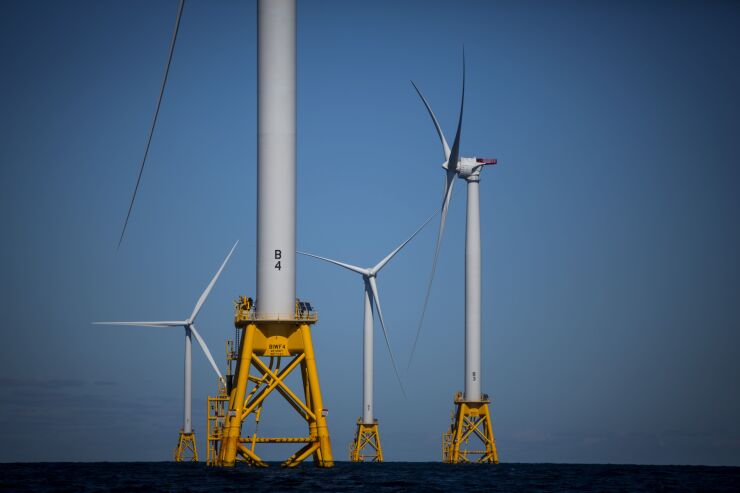Connecticut, Rhode Island and Massachusetts have agreed to work together to develop offshore wind energy in a joint venture officials say will offset rising costs that threaten the burgeoning industry's potential.
The multi-state coalition will be the first of its kind, Massachusetts Gov. Maura Healey said
Doing so can help reduce costs through development at scale and help keep the region ahead of growing competition on offshore development, they said.

Efforts to develop the U.S. offshore wind industry,' have been fueled by state regulations opening up legal avenues for new development and the implementation of federal incentives, including an investment tax credit of 30% included in the Inflation Reduction Act, in an effort to incentivize carbon-free electricity generation.
Those incentives have led to "significant increases in near-term wind deployment forecasts," the Department of Energy found in its
DOE said that wind power accounted for 22% of new electricity capacity installed in the United States in 2022, second only to solar, and drew $12 billion in capital investments while employing more than 125,000 people nationwide.
The largest concentration of new projects was in the country's Northeast, where state governments along the Atlantic have jockeyed for contracts by offering up their own incentives in addition to federal programs.
But U.S. offshore wind projects are running into headwinds driven by escalating costs.
More project approvals regionally meant more competition that squeezed supply chains and drove material and labor costs higher, the DOE report said.
Coming amid a persistent inflationary environment, some developers in the region have rethought major projects.
New Jersey's Ocean Wind, the U.S.'s largest offshore wind project, is now facing an uncertain future after its developer, Danish energy giant Ørsted, said it saw $2.3 billion in losses in its U.S. operations last year.
Ørsted CEO Mads Nipper told shareholders in an earnings update in August that inflation, supply chain woes, and labor costs were largely to blame and the company would delay the opening of the facility until at least 2026 while reevaluating plans for a second offshore wind farm off of New jersey's coast.
Ørsted is also a key player in New England offshore wind, partnering with investor-owned utility Eversource to develop the
In neighboring New York, a national leader in offshore development investment, Gov. Kathy Hochul on Thursday
Smaller ventures underway in New England face similar stress; in Connecticut, electric utility Avangrid pulled out of the state's largest offshore wind project, Park City Wind, due to the project's growing financial infeasibility, while two wind energy developers in Massachusetts, SouthCoast Wind and
In Rhode Island, Rhode Island Energy recently terminated its power purchase agreement with Ørsted and Eversource for the offshore wind farm Revolution Wind 2.
According to the DOE, projects nationwide, particularly those with an expected start of commercial operations between 2025 and 2028, are facing challenges in maintaining "economic viability because of rising capital costs and interest rates."
While state governments have procured 27 offshore wind power offtake agreements, no new offtake agreements have been signed since May 31, 2022, with several projects announcing intent to renegotiate or cancel current contracts.
"As a result, some projects have asked their offtake counterparties or states to renegotiate the terms of their offtake agreements," DOE said. "As a buffer to make future offtake agreements more durable, some states have now introduced inflation indexing as part of their forthcoming offshore wind procurements."
There is a historic amount of investment in renewables, said Joseph Kane, a fellow at Brookings Institute, but there is also an "enormous need" for greater coordination across federal, state and local governments to effectively harness resources.
"We're kind of jamming this money through outdated programmatic and policy frameworks," he said. "It's one thing to say we have historic federal investment in infrastructure, but there's still a need for all of these sub-national actors to coordinate on that."
In the current economic and market environment, states have been prodded into seeking out new methods to bring down costs without increasing rates.
New England's response, the new multi-state venture, will attempt to leverage collective resources and bargaining power to drive those costs down in the near and long term, officials said.
According to the agreement, states will begin separately accepting and reviewing proposals from offshore wind developers for multi-state projects sometime within the next year.
Project selection will depend on each state's assessments of proposals' costs and benefits to ratepayers and other evaluation criteria specified to each state's requests. Projects involving just two states will also be considered.
"Massachusetts is proud to join with our neighboring states to continue to grow New England's offshore wind industry," Healey said. "By working together, we can amplify the many benefits of offshore wind for all three states, including regional economic development opportunities, healthier communities, lower energy bills, and advantages to environmental justice populations and low-income ratepayers."
"In coordinating, the states will amplify efforts to foster regional economic development, create high-paying, in-demand jobs, and promote environmental justice and equity," officials said.
Combined, Connecticut, Rhode Island, and Massachusetts are seeking to produce up to 6,000 MW of offshore wind, enough to power nearly 4 million homes, with their first round of proposals.
Kane said that while "a huge amount of confusion" exists on several aspects of national wind energy implementation and questions remain on the speed of development and lagging return on investments seen so far, it's good to remember the industry is still in its infancy.
"What I like to stress is, in addition to the short term, is there's gonna be a long tail to all of this," Kane said.





